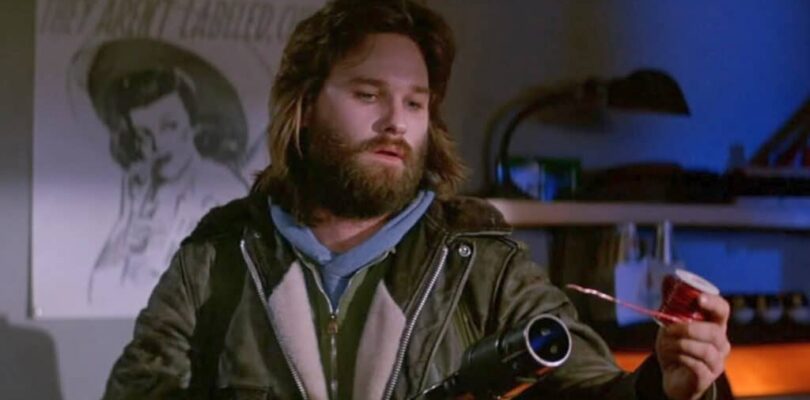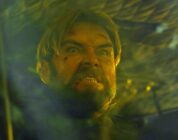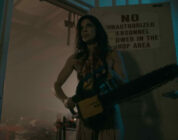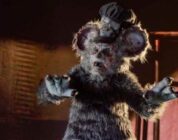Admit it – there’s at least one horror movie out there with a “gotcha” moment that made your heart slam against the inside of your ribcage. A sudden out-of-nowhere reveal, often accompanied by a loud noise on the soundtrack. Scenes like this have been making audiences soil their seats since the era of classic monster movies, and it’s not hard to see why. The response is hardwired into our brains; an instinctive fight-or-flight reflex when our natural defense mechanisms are rudely interrupted. The term “jump scare” wasn’t commonly used to label this effect until the 21st century, and it only really became part of popular culture after the birth of YouTube – which practically weaponized the technique with viral “screamer” videos and clip compilations.
Legendary director Alfred Hitchcock once famously criticized this kind of scare tactic, claiming suspense far is more effective than a sudden shock… but he’s also responsible for one of the most iconic screen jumps ever in Psycho. Even legendary genre filmmaker John Carpenter, who himself has given us some of cinema’s most memorable jolts, often downplays the technique as a “cheap trick.” But he always seems to know how to make it work.
With that in mind, I’ve compiled a list of horror scenes that employ these short, sharp shocks in ways that have become iconic to the genre – and in some cases, they’re the first thing we associate with the movies themselves. I like to think these movies manage to earn their scares, as opposed to just sucker-punching your senses for an easy reaction. Of course, what makes you jump might only merit a “meh” from someone else, and viewers are pretty jaded after having been subjected to this kind of cinematic abuse over and over again. But you’ll have to agree many of the shocks listed below remain pretty damn potent today – sometimes several decades after they first traumatized movie audiences.
Just a note before we begin: there are tons of non-horror movies that feature memorable shock scenes (for example, “Large Marge” in Pee-Wee’s Big Adventure or Bilbo’s transformation in The Lord of the Rings), but I’m keeping this list focused on the horror and thriller genres. Also, it’s not all about the classics here –there are dozens of lesser-known horror films featuring unforgettable heart-stopping moments of their own, and I’ve listed some of them here. But there’s always room for another list, so be sure to let us know which ones you’d like to see included next time!
Oh, and one last warning: this list is pretty much wall-to-wall spoilers, so keep that in mind before you dive in…
CAT PEOPLE (1942): The Bus
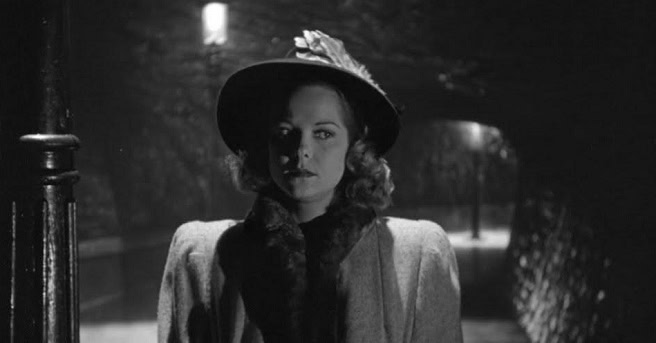
By far the oldest entry on this list, this one might seem out of place. But it’s arguably the first true jump scare in movie history. Ironically, this moment is one of the best-remembered in the filmography of producer Val Lewton, best known for creating a moody, dreamlike atmosphere in slow-burn films like I Walked with a Zombie and Isle of the Dead, which never resort to cheap shocks. Maybe that’s why it works so well – after all the slow and deliberate suspense, audiences had no idea the director was about to smack them with an unexpected loud noise. The moment comes when one of the main characters is nervously walking the city at night, already on edge with the suspicion she’s being stalked by her romantic rival – a mysterious woman who may not be entirely human. The potential victim and the audience get goosed by a sudden screech on the soundtrack – which turns out to be the brakes of an arriving bus. It’s not scary enough to jolt modern audiences, but I’m including it here because it’s arguably the mother of all horror movie jump scares.
THE TEXAS CHAIN SAW MASSACRE: Introducing Leatherface
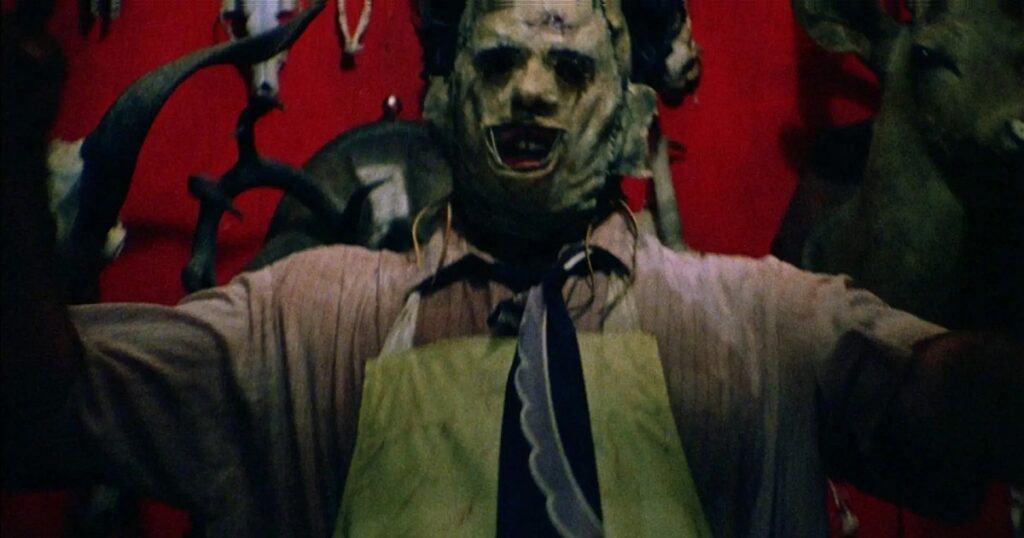
The 1970s and ’80s gave us several horror villain characters who are still beloved by many horror fans to this day: the slasher icons. The first of the batch to reach the screen was Leatherface, in director Tobe Hooper’s 1974 classic The Texas Chain Saw Massacre (yes, Hooper thought chainsaw should be presented as two words) – and his first appearance is one that can really rattle your bones. Running low on gas during an idyllic summer afternoon drive, a couple decides to stop by a farmhouse to see if they can score any gasoline from the residents. Finding the front door open and strange animal sounds coming from inside the house, a young man enters the residence, approaching a doorway… and when he reaches that doorway, a hulking, hammer-wielding man wearing a mask of flesh steps into view. And brings his hammer smashing down on the young man’s head. Things get even more terrifying from there, but the first appearance of Leatherface is an unforgettable moment.
JAWS: Ben Gardner’s Boat
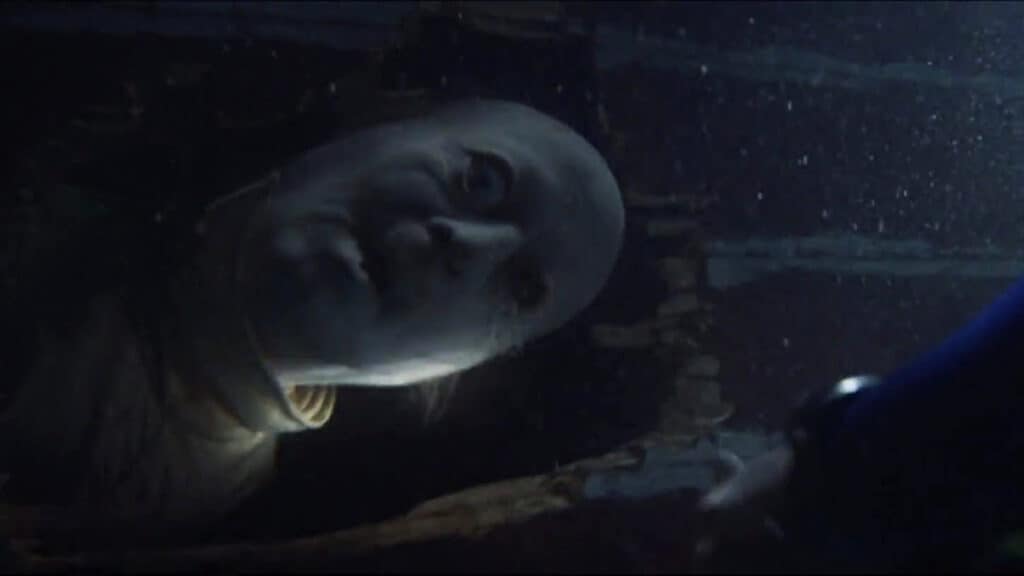
Believe it or not, there are still people who have yet to experience the game-changing 1975 blockbuster that made Steven Spielberg a household name – and when they do finally get the chance, this scene still manages to send their popcorn flying. It helps that Spielberg and his team were forced to use a “less-is-more” approach in their depiction of the 25-foot killer Great White, thanks to faulty effects that seldom worked. For this reason, we’ve had no clear glimpses of the shark up to this point, leaving audiences on constant alert for the predator to reveal itself. The scene also takes place at night and underwater, so we’re already filled with the dread of what might be lurking in total darkness. But it’s not the shark that provides the movie’s biggest surprise: it’s the bloated body of fisherman Ben Gardner, which pops up like a jack-in-the-box from a hole in the destroyed hull. It’s so unexpected that even seasoned oceanographer Matt Hooper has a complete freakout, causing him to drop the one piece of evidence he needed – a massive tooth – to prove the shark was still patrolling the waters around Amity Island.
CARRIE (1976): The Hand
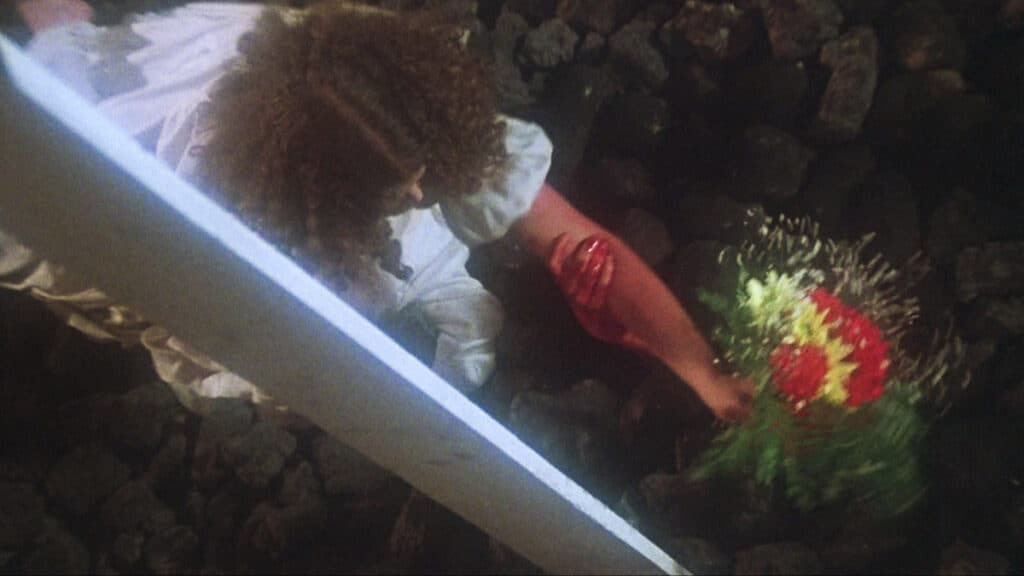
Brian De Palma’s classic adaptation of Stephen King’s first novel is beloved by horror fans for many reasons, but it really sticks in our collective consciousness thanks to the epilogue, which almost didn’t make it into the film. In the decades since its release, we’ve seen plenty of “it was just a dream – or was it?” moments very much like this one, but the original still packs a punch, even if you’ve seen the film a dozen times. The scene comes after high-schooler Carrie White has telekinetically slaughtered nearly everyone at her high school prom, as well as her psychotic mother, who manages to fatally stab Carrie before dying horribly. Tormented with guilt about her own mistreatment of Carrie, survivor Sue Snell sleepwalks up to their demolished house to lay flowers on the pile of rubble that remains… before Carrie’s hand breaks through from below to grab her. This turns out to be a dream; it’s actually Susan’s mother holding her arm. But that (literally) groundbreaking shock will live on as one of the all-time classic horror movie jump scares.
ALIEN: The Air Shaft
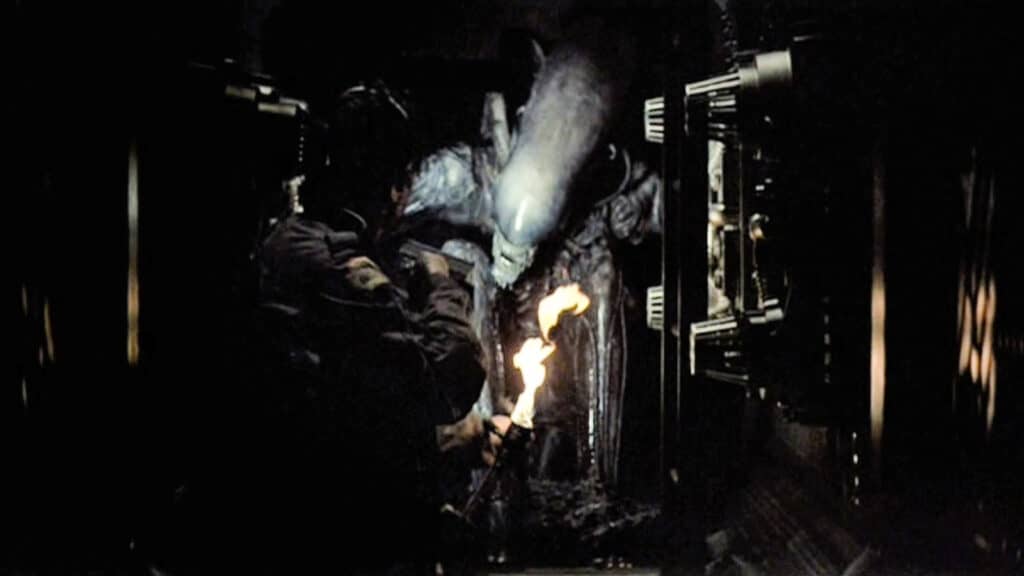
You can’t get more old-school than Ridley Scott’s iconic 1979 sci-fi horror epic. As with many of the titles on this list, the sudden shocks scattered throughout its runtime are given extra weight by an overwhelming fear of the unknown. This dread consumes the crew of the Nostromo, and that fear is shared by the audience. While the movie made history for the “birth scene” that became its gruesome centerpiece, and the birth itself certainly came as a shock, we were prepared for the worst. That can’t be said for the nail-biting sequence in which Captain Dallas crawls into the ship’s narrow ventilation system where the fully-grown monster is known to be hiding. His shipmates try to guide him with a tracking device, but it’s malfunctioning, and it only enables them to watch helplessly as one tiny dot on the monitor moves closer to the other. The suspense has already built to an unbearable level as the usually stoic Dallas begins to panic and makes a hasty retreat – only to run headlong into his doom. A jolt of static hammers home the effect, audiences worldwide soiled their seats, and history was made.
FRIDAY THE 13TH (1980): Alice Meets Jason
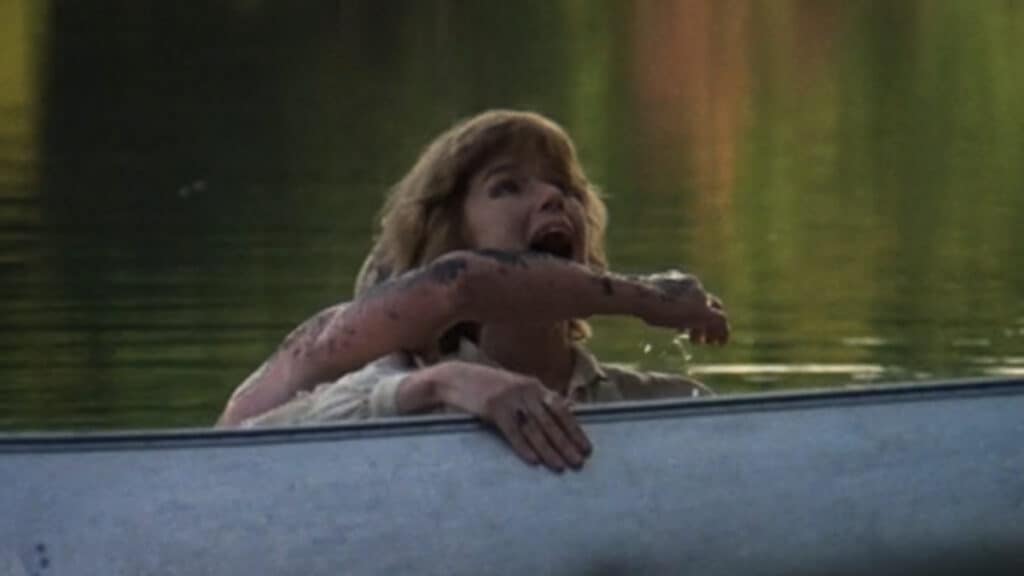
While it blatantly cops the same final scare that Carrie pulled off five years earlier, this epilogue to the slasher classic still had a similar effect on audiences back in the day. Sure, it seems obvious now – the whole slow-motion lake scene is an obvious setup for the final payoff – but it’s now legendary for introducing us to notorious screen villain Jason Voorhees, whom we had been led to believe drowned in Crystal Lake many years ago. This “twist” makes no logical sense, but definitely dropped the bomb on unsuspecting viewers. It just so happens that scene wasn’t even in the original script; FX guru Tom Savini thought he could get one final scream out of the audience – and to accomplish that, he lifted Carrie’s finale, even down to the possibility that it was all a dream. If it weren’t for this last-minute addition, Friday the 13th may never have become a beloved horror franchise… or at least it would have turned out a whole lot different. But today it still stands tall among horror movie jump scares.
AN AMERICAN WEREWOLF IN LONDON: Two Dreams in One
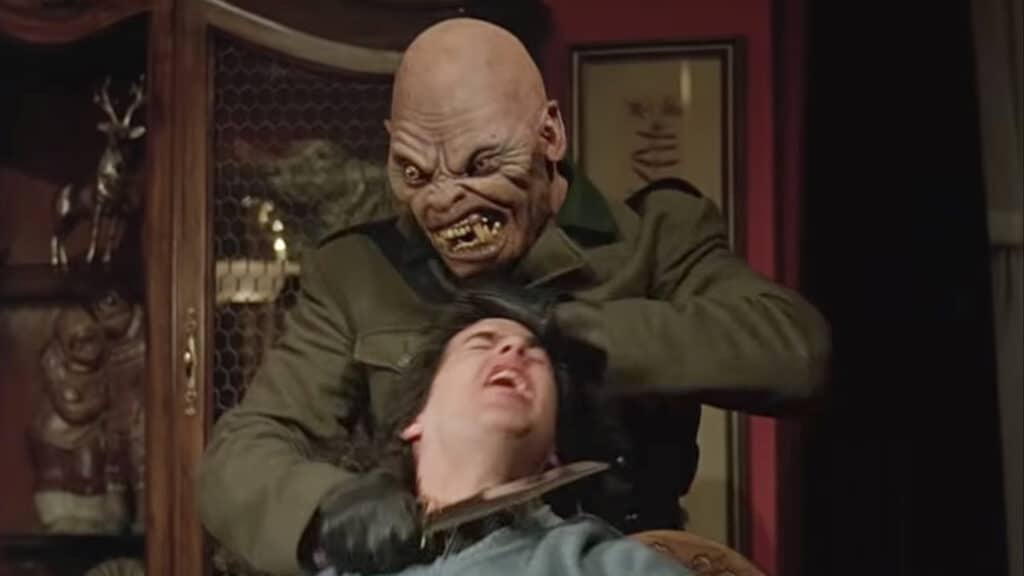
Imagine the reaction from audiences lured into John Landis’s amazing horror-comedy hybrid by the ad campaign, which focused on the comedy angle (“From the director of Animal House comes a different kind of animal”). After the first werewolf attack sets the plot in motion, I imagine a few viewers had already crapped themselves – but it just gets scarier from there. There are plenty of shocking moments to choose from, but one that still freaks out audiences today employs the “dream-within-a-dream” trope, which hadn’t been abused too much back in 1981. While you’re still reeling from a bizarre and unexplained nightmare sequence involving a band of mutant Nazi soldiers mowing down the protagonist’s entire family, Landis hits you with one more shock: although he thinks he’s awake (and so do we), we realize the dream isn’t over when one of the mutants leaps from behind the curtains to brutally murder his nurse. It’s so freaky, it runs a close second to the werewolf transformation sequence as the scene that viewers remember most.
THE THING (1982): The Blood Test
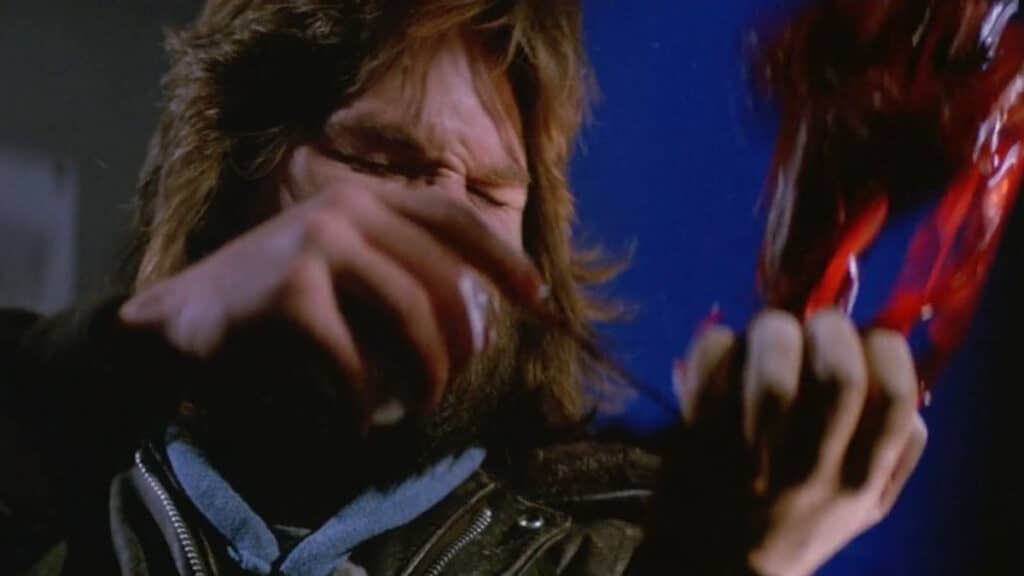
Even though John Carpenter seems embarrassed to use jump scares, he’s responsible for quite a few of them – and damn good ones at that. He usually juices those shocks with musical stingers and sound effects (that he himself creates), but the most shocking scene in his filmography comes with no music cues whatsoever. It arrives at a point where the film’s suspense has built to a critical level, as several members of an Antarctic research outpost have been killed and perfectly imitated by an alien creature. Up to now, there’s been no way of knowing which of them are doppelgangers; we only know not everyone is who they appear to be. After a disastrous encounter (which also provides a classic jump moment), helicopter pilot R.J. MacReady suspects the alien is a collective organism, and every part of it has its own instinct for self-preservation. He devises a crude test, in which he takes blood samples from each of the men, then prods each sample with a red-hot wire. We’re not sure the test even works until the wire contacts the sample from Palmer, a deadbeat stoner who’s not even one of the prime suspects. The blood doesn’t just try to get away from the heat… it screams and leaps from the dish. This epic scene still catches first-time viewers off-guard.
THE EXORCIST III: The Corridor
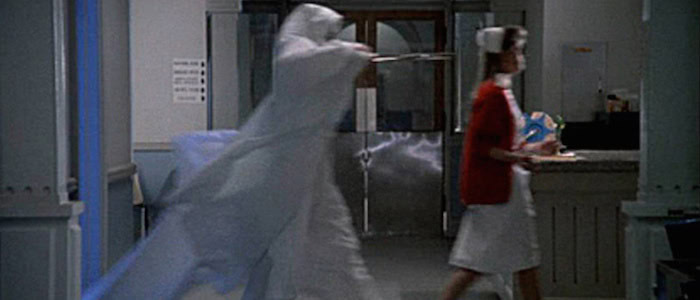
While not historically significant as The Exorcist, this 1990 sequel is notorious thanks to one heart-stopping scene. Throughout the film, Detective Kinderman has been engaged in a battle of wits with the spirit of “Gemini Killer” James Venamun, now inhabiting the body of Father Damien Karras. Stuck in his cell, the Gemini is still capable of carrying out his M.O. by possessing the bodies of fellow patients. The peak moment comes late one night, after Kinderman has ordered a lockdown of the entire hospital. We know something terrible is going to happen – the night-shift nurse fits Gemini’s victim profile – but director William Peter Blatty (who wrote The Exorcist novel and its sequel Legion, on which this film is based) isn’t letting us off that easy. That’s what makes the jump so effective: we know it’s coming – we just don’t know when. It’s not only one of the supreme horror movie jump scares, it’s also a master class in how to balance suspense and shock in the same scene. Take that, Mr. Hitchcock!
SEVEN: Sloth

If you claim not to have been freaked out by this totally unexpected moment in David Fincher’s grisly serial-killer thriller, you’re probably lying. Just admit it – you thought that emaciated, rotting corpse-like figure in the bed was either long dead, or at least in a completely vegetative state… until one of the cops investigating the scene leans closer to the victim’s face and gets the shock of his life. It may be just a reflex, but that thing on the bed isn’t quite dead – as revealed by a sudden, explosive coughing fit. In a movie about a serial killer who devises fatal “punishments” for his victims, about the last thing you’d expect to see would be one victim left alive, at least technically. But that shock not only shatters your expectations; it also hammers home the horrific methods used to punish this particular offender. Strapped to a bed, he’s been deliberately kept alive and possibly even conscious enough to feel what he’s going through as his body slowly rots away, sustained by nothing more than an IV drip. Even when the initial shock wears off, the horror of what this victim has endured (whether he deserves it or not) will stick with you for a long time.
AUDITION: The Bag
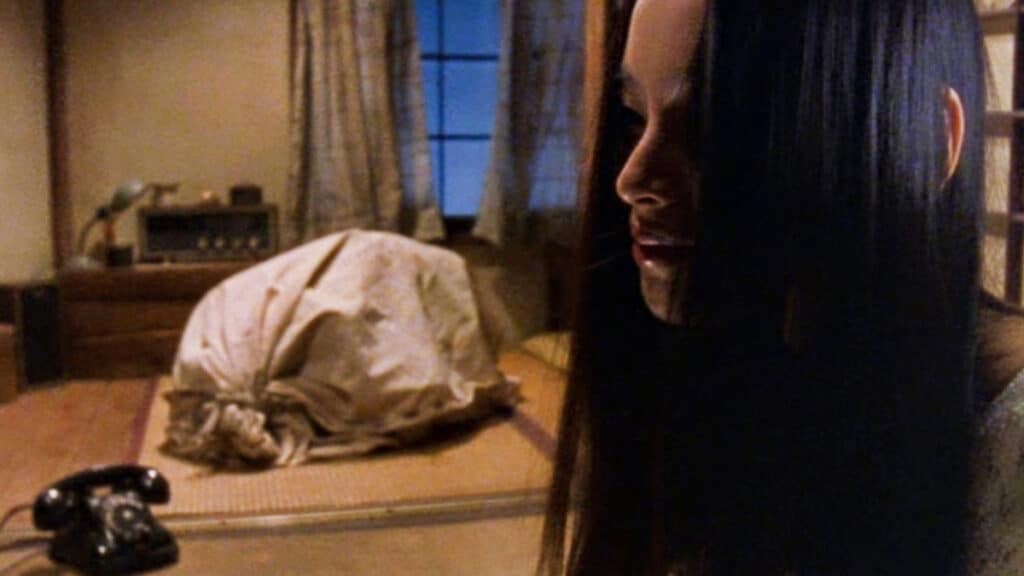
Notorious Japanese director Takashi Miike achieved international fame with this brilliant and subversive project. It’s one of the best examples of a film starting out as one kind of story, only to do a complete 180, punch you dead in the face and say, “what do you think of that?” The first hour is devoted to a melancholy comedy-drama, leading horror-hungry viewers to wonder if they stumbled into the wrong movie. It’s also very inappropriate, following a recently-widowed film producer who fakes a movie audition in order to find a new female companion. We all know he’s going to pay the price… but again, we don’t know how or when. Both answers come at the film’s midpoint, in which the producer decides to call Asami, a seemingly meek and innocent woman whom he recently stood up after getting cold feet. We realize how huge a mistake he’s made when the phone rings loudly in her apartment – and the sound causes something inside a huge burlap sack to convulse and leap across the room. The events that follow are legendary among extreme horror fans, but this turning point is by far the most frightening moment in Miike’s massive filmography.
THE RING (2002): The Closet
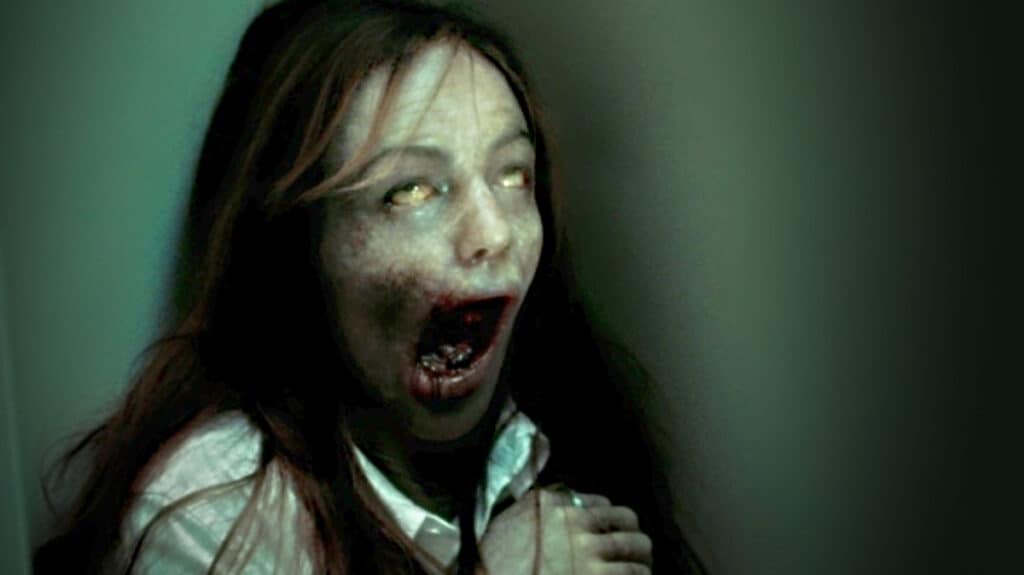
There weren’t any big shocks to be found in the 1998 Japanese horror classic Ringu, but the story was driven by a sense of doom as a curse’s one-week clock rapidly approached its climax. Gore Verbinski’s remake manages to capture the same bleak, grim tone of the original, but it’s best remembered for one brief, almost incidental fright. During the wake service for Katie, the most recent victim of the curse, we can already feel the encroaching horror, even if it hasn’t reached the heroine yet. But when Katie’s mother recounts the mind-shattering horror of finding her daughter’s disfigured corpse at the back of a closet, her face frozen in a grotesque scream, we get a smash-cut flashback revealing what she saw. The result is a terrifying taste of the emotional trauma that discovery must have triggered. It might feel like cheating to jab the audience with that shot (and the accompanying sound effect), but it still ranks high as horror movie jump scares go, and it raises the stakes for the horrors to come.
SIGNS: The News Broadcast

M. Night Shyamalan is obviously more famous for creating wild twists that turn his plots upside-down, crushing everything we thought we knew up to that point. It doesn’t always work, but it’s still his signature move. With this 2002 film, the director adopted a new approach: there’s no question there are shadowy humanoids lurking on a family’s farm, and we know early on that they’re aliens – but it’s the way these beings reveal themselves that injects the film with sudden menace. They’re seldom in-your-face scares – instead, the terror comes from quick “did I just see that?” glimpses of the invaders. One of these is a moonlit reveal on the roof of a barn, but the scene that really stung audiences came in the form of a news broadcast. The breaking story shows a kid’s birthday party in Brazil erupting into screaming chaos when partygoers spot one of the beings, and the moment is captured on camera. It’s the documentary-style reveal of the incident that really amps up the terror, as the unseen menace has finally been spotted.
[REC]: The Attic
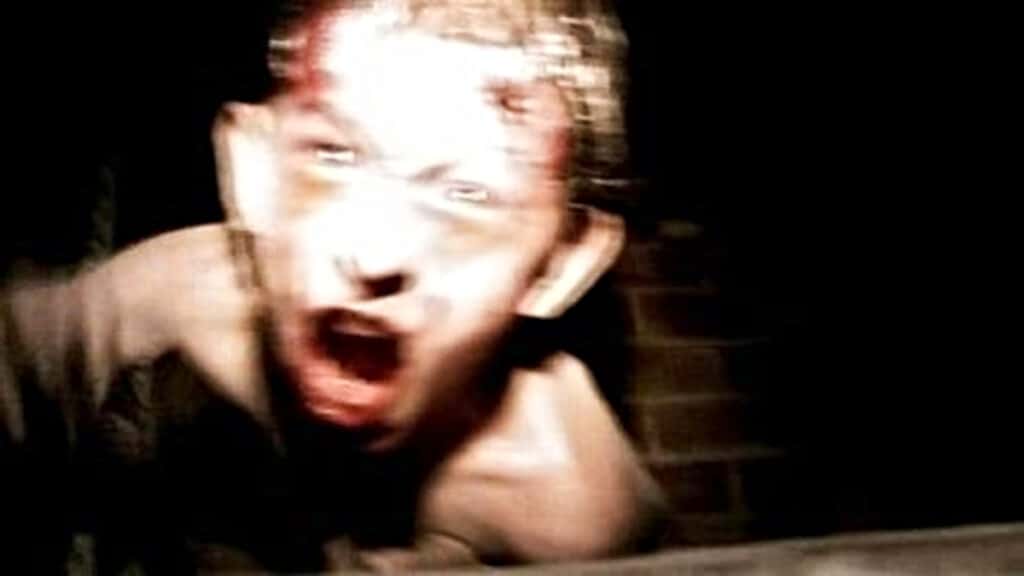
The scariest moment in this already frightening found-footage flick had such an impression on director Rob Savage that he incorporated it into a video edited to scare the crap out of his friends on a Zoom call – a scenario which Savage and several members of that creative group would soon expand into the chilling pandemic-based film Host. The moment comes in the final act, where we discover the zombie plague which has been tearing through the residents of a small apartment building is connected to a failed exorcism. The evil force is then passed along like a fast-acting virus, turning the tenants into murderous ghouls. With the power knocked out and only a night-vision camera to guide reporter Ángela Vidal and her cameraman, we’re brought along as they slowly climb to the building’s attic in an attempt to escape the hordes of infected. Of course, the room is currently occupied, and we learn this in no uncertain terms when the camera pans around the seemingly empty space… and although we know something is waiting up there, we don’t know where or when it will emerge from the darkness. Creepy kids are always nightmare fuel, but this zombie boy has straight-up murder on his mind – and he lets us know this as soon as the camera’s eye reveals him.
THE DESCENT: The Crawlers
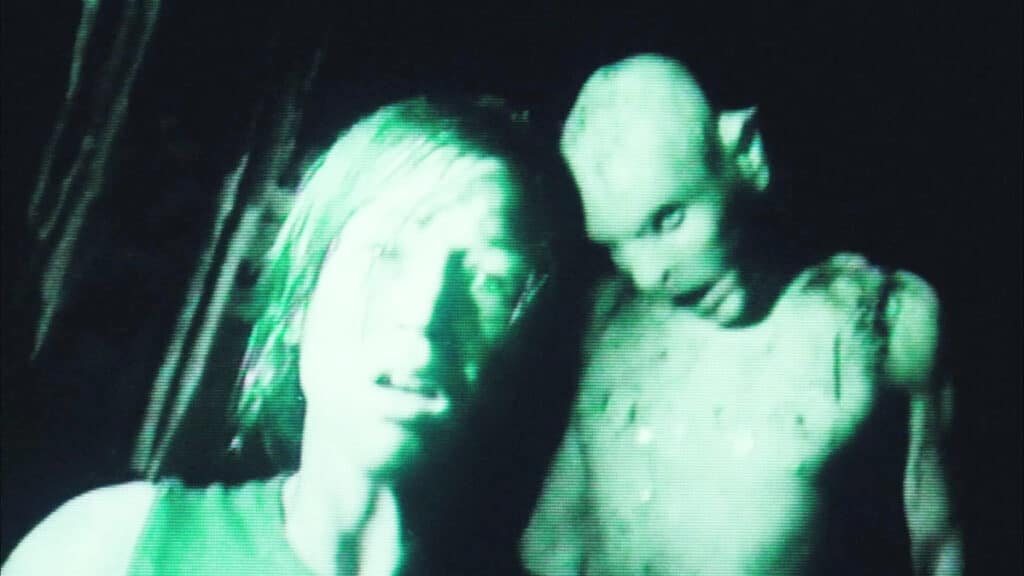
This isn’t the only scene on this list that involves a night-vision POV to disorient the audience with vague, green-tinted images, but it’s definitely one of the most memorable. Trapped deep inside a massive cavern with no means of escape, six friends on a caving expedition are succumbing to panic after one of them is badly injured in a fall and their light sources are starting to fizzle out. One of them thinks she caught a glimpse of someone else in the cave with them, and while the others begin calling out for help, she continues to scan their surroundings with her camera’s low-light viewfinder. Soon, we see what’s been lurking just out of view: a cave-dwelling subhuman creature, standing just inches behind one of the cavers. In one second, the already-tense scenario of escaping an underground prison is instantly shifted into literal Beast Mode. A tribe of primitive carnivorous creatures nicknamed “crawlers” has been stalking the friends all this time… and now dinner is served.
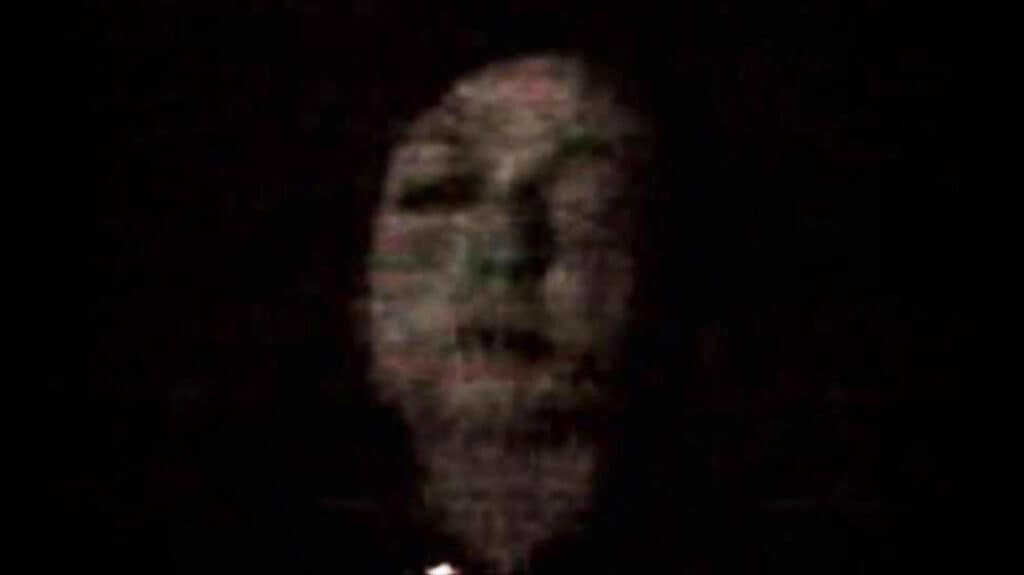
This slow-burn mockumentary from Australia finally peaks with a huge final-act reveal. One of the best faux-docs ever made, horror or otherwise, Lake Mungo chronicles the events leading up to and following the tragic drowning of troubled teenager Alice Palmer, initially focusing on her family’s trauma – especially that of her brother, an amateur photographer who claims to have discovered her faint ghostly image in several of his photographs. Midway through the film, the story takes a surprising turn… then takes another one, then another, throwing a wrench into everything you’ve been told up to that point. But the final plot twist comes in the form of a shaky, pixilated camera phone video taken by Alice when on a field trip to the title location. Not only does the phone’s footage reveal what’s really been haunting her in the months leading up to her death, it does this in the most terrifying way possible, resulting in one of the most haunting horror movie jump scares. This one will stick with you long after the credits (which contain a few surprises of their own).
THE HOUSE OF THE DEVIL: Not the Babysitter?

When you mention director Ti West, the term “slow burn” likely springs to mind. His cult classic The House of the Devil is a perfect example of this mumblecore-inspired technique, coupled with a nostalgia for the horror films of decades past. This leisurely path to the scary stuff is not for all tastes, but audiences are often rewarded for their patience with well-planned shocks. West’s third feature also showcases his best jump scare, and it’s a doozy. Our protagonist wanders aimlessly through the house where she’s supposedly “babysitting” an unseen character, oblivious to what seems to be an inevitable confrontation; meanwhile, her laid-back best friend is sitting in her car after dropping her off at the house, pausing for a smoke break on the way home. She is startled by a surly visitor – an intense character we’ve never seen until this point – who appears to be delivering a pizza to her friend. He’s also a bit confused as to whether she’s the babysitter or not, so he asks her. She barely has time to respond in the negative before he levels a previously-unseen pistol at her head, and without a second’s hesitation pulls the trigger. This is one of those out-of-nowhere jumps that shouldn’t work, but amazingly it does: while we’re watching bits of skull and brain dripping down the windshield, we haven’t even had time to process what just happened.
INSIDIOUS: The Lipstick Demon
James Wan was in full spookhouse scare mode in 2010 when he directed the first entry in this paranormal horror franchise – and for my money, this is still the creepiest film in the series. Wan uses every tool in the horror-movie handbook here, but most of them still feel fresh. Up to this point in the story, the scares have been eerie and elusive, with more emphasis on dread than outright shock. But it’s just one simple, short static shot that blew audiences through the back wall. Lorraine, mother of protagonist Josh Lambert, is recounting a nightmare about a red-faced demon, who now has its sights on her grandson; while she revisits the trauma of her own confrontation, the demon is revealed to be taunting her – and for one nightmarish second, we see that bizarre face crouching just behind her son, snarling at her (and us). Actor and composer Joseph Bishara sells this shock in two ways: through his animalistic expression under all that makeup, and with a jarring musical stinger.
SINISTER: The Lawnmower
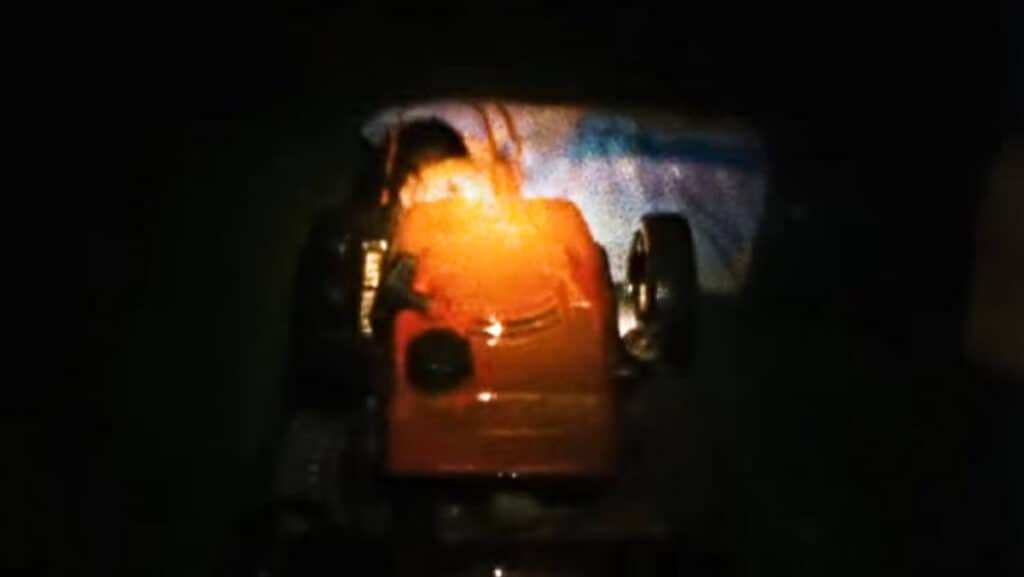
I don’t scare easily at the movies, so I have to give this scene a what-what for smashing through my defenses… and that’s reason enough for me to rank it as one of the all-time best horror movie jump scares. The scare comes in one of several extremely creepy Super-8 film reels found by crime author Ellison Oswalt in the attic of a house where an entire family (except for one child) was brutally murdered. The silent reels are all nightmarish, accompanied only by the sound of the projector and dark ambient music cues, but this one stands out because, just like in Exorcist III, we know something’s coming; we just don’t know what or when. The reel ends with a blurry POV shot of the unseen killer pushing a lawnmower on a rainy night… until the machine encounters an obstacle in the form of a bound and gagged victim. We don’t even see what happens to them, and frankly we don’t have to.
IT FOLLOWS: The Tall Man
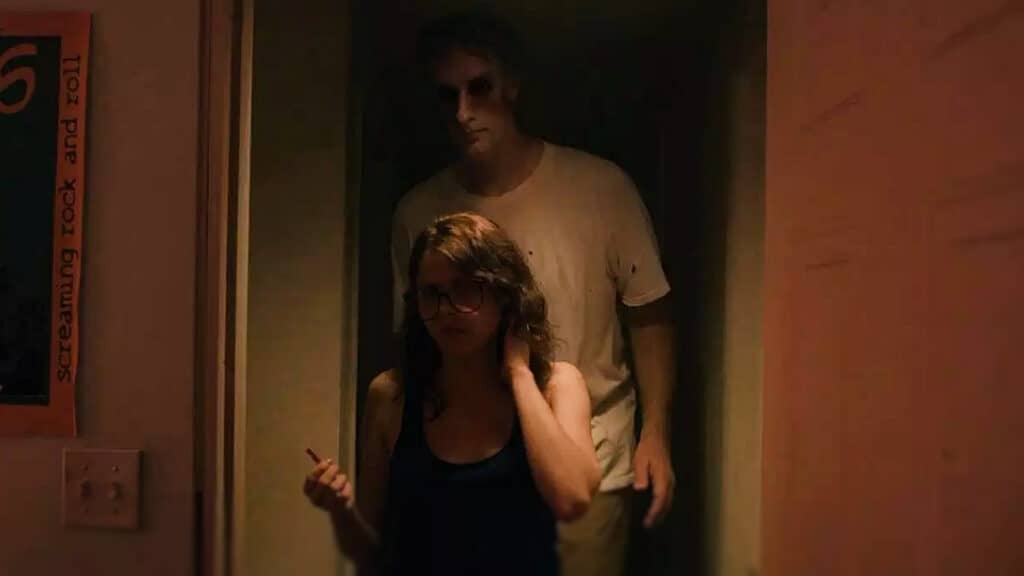
Like The Ring, this modern horror classic generates an atmosphere of slowly-escalating doom as the protagonist tries to outrun a curse that’s been passed on to her. The cause of the curse –transmitted by sexual intercourse – is nowhere as frightening as the way it reveals itself. To reach its victims, an unknown force takes the form of anonymous people – or in some cases, more familiar characters. Their origin isn’t important; it’s scary because literally any character could be one of these stalkers. Tension builds to the point where we’re scanning every inch of the frame for one of the “followers.” Occasionally the scares come on hard and fast – particularly in the scene where protagonist Jay and her friends are hiding in a bedroom from the approaching menace. Director David Robert Mitchell does a sweet fake-out by revealing the person behind the door is another one of her frightened friends… distracting them (and us) from the real threat: a huge, sunken-eyed man who suddenly fills the doorway behind her.
HEREDITARY: Mom Attacks
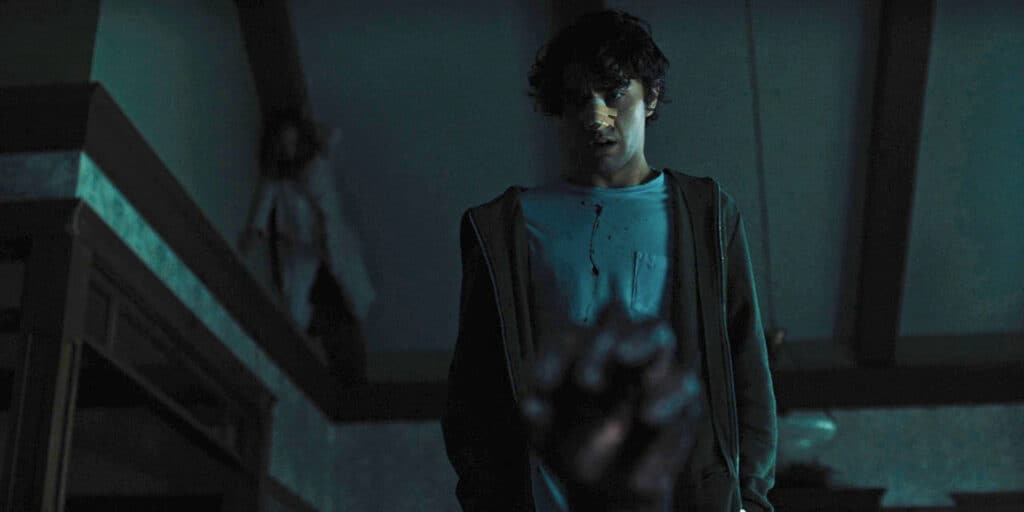
One of our more recent entries comes in a film nearly overflowing with traumazing moments, but this scene in particular really gave audiences a kick in the head, and it’s one of only a handful of horror movie jump scares from art-house horror studio A24. Viewers already knew artist Annie Graham has been spiraling into madness long before the demon Paimon takes control of her, so they were prepared for the worst – or at least they thought. Once Annie sets her demonic sights on her son Peter, she’s become a literal monster. Leading up to this, we’ve caught terrifying glimpses of Annie hanging from the ceiling like a spider, poised to pounce on her unsuspecting son. After he finds the charred corpse of his father, we see her scurrying across the walls and ceiling in silent pursuit. But once he’s frozen in fear, unable to process what’s going on, she makes her move. Mom bursts from the shadows and comes after him at top speed, inches behind him as he runs desperately to escape. The movie gets even weirder, but this is the mark when various paranormal goings-on stop being ambiguous, and the final act shifts gears into straight-up horror.

